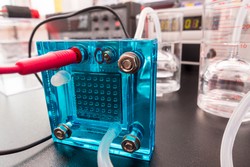Fuel cell technology to help power the world to a greener future
A few years ago, top European scientists began developing a new kind of fuel cell dubbed the IDEAL-Cell. Now, their new technology retains all the good of the old and none of the bad. In existing solid oxide fuel cells (SOFCs) and proton conducting fuel cells (PCFCs), oxygen and hydrogen react to create electricity and water. This water by-product collects at the cell’s oppositely charged electrodes, resulting in corrosion and a lowering of the cell’s efficiency. The EU-funded IDEAL-CELL (Innovative dual membrane fuel cell) project developed a way to prevent this collection of water. Following intensive shaping, modelling and electrochemical testing, project partners successfully demonstrated the proof of concept. Based on this concept, hydrogen, oxygen and water are located in three separate compartments. The formation of water does not occur at the cathode or the anode, as is the case with standard PCFCs and SOFCs, respectively. There is no need for a gas counter flow to sweep the water away from the catalytic sites in the electrodes. Pressure can be applied easily to both anodic and cathodic compartments to boost overall efficiency. Researchers demonstrated that IDEAL-Cell operates optimally in the 600-700 °C range. They estimate fuel and electrical efficiency increases from 40 to 80 % and 50 to 75 %, respectively. These performances exceed other high-temperature fuel cell configurations. The IDEAL-CELL team employed cutting-edge experimental and theoretical methods to improve electrode and electrolyte materials, discover new mechanisms, and establish and validate a full theoretical description of the cell. With obvious advantages in performance, durability and cost, IDEAL-CELL advances have the potential to bring important innovations to the field of high temperature fuel cell technology for stationary applications. It will also contribute positively to the future energy landscape.
Keywords
Fuel cell, SOFC, PCFC, IDEAL-CELL, dual membrane fuel cell



